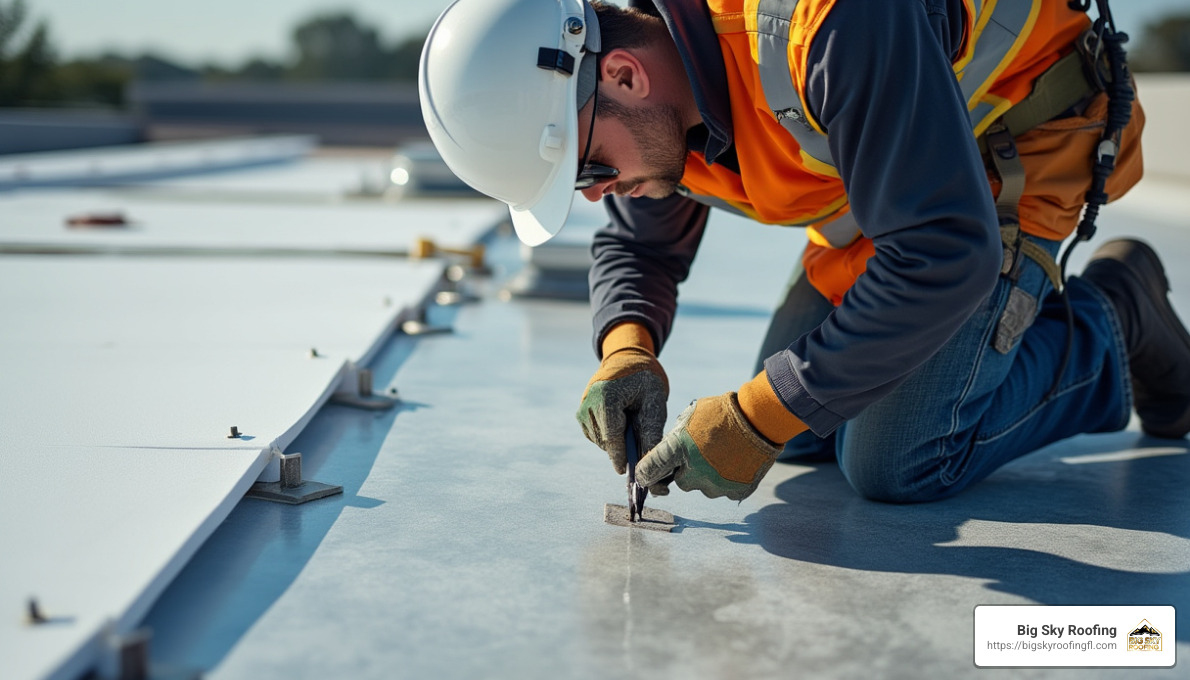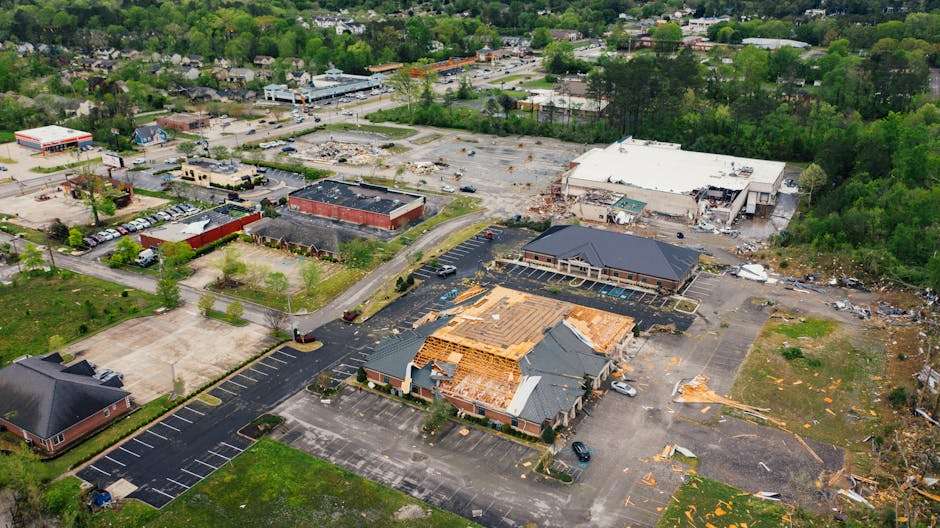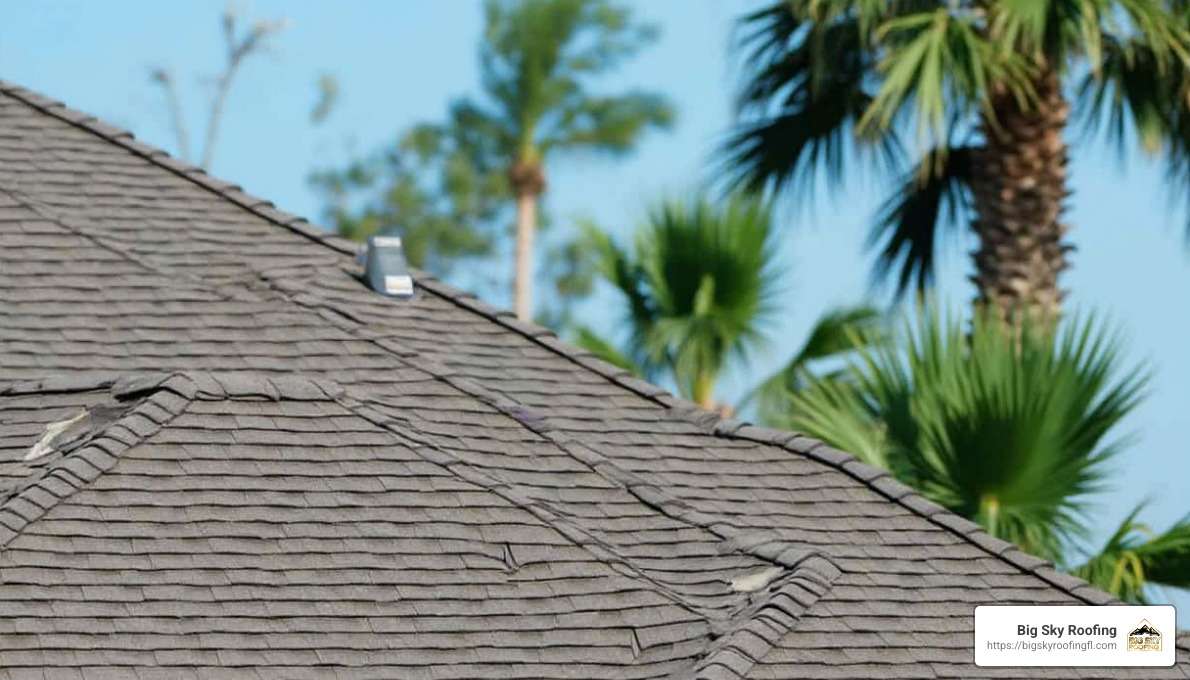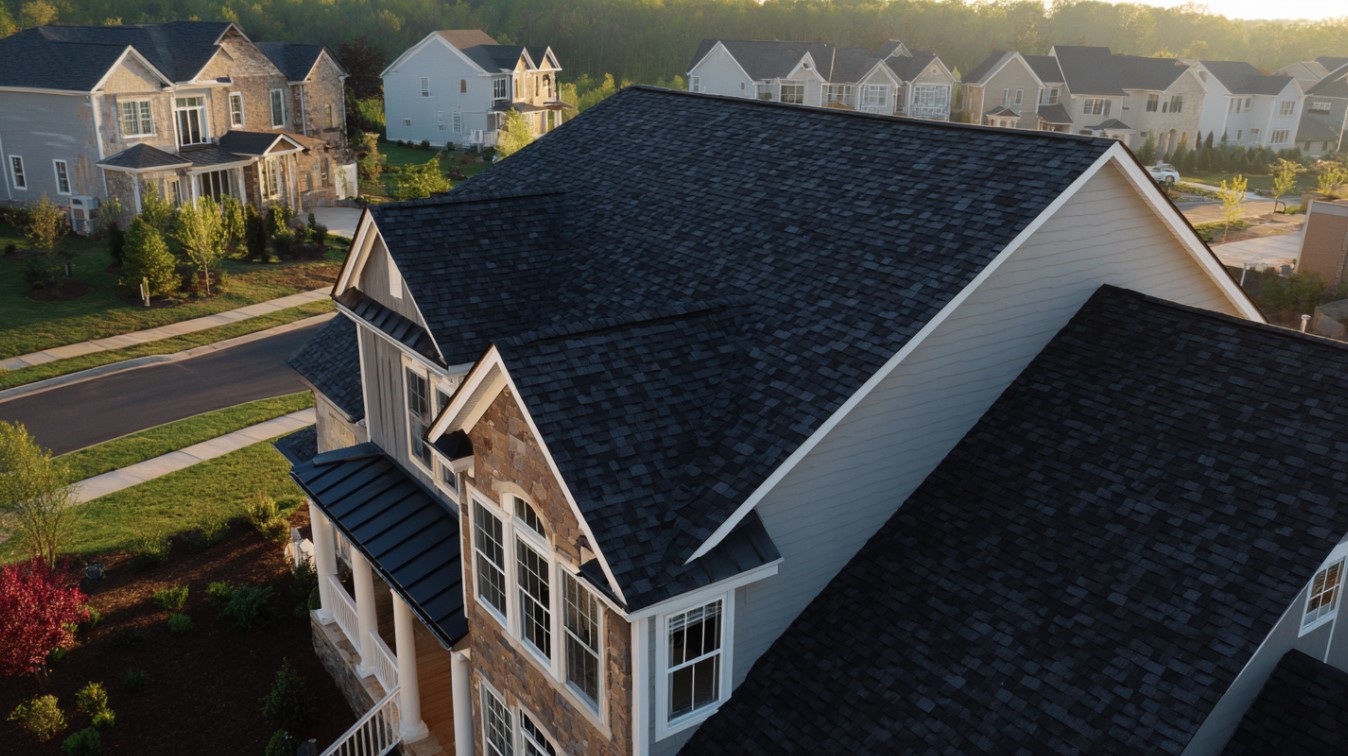TPO Roofing: How Durable Is It Really?
•
Written By

TPO roofing durability is a key consideration for Florida homeowners seeking reliable protection against the elements. Thermoplastic Polyolefin (TPO) roofing is renowned for its energy efficiency, cost-effectiveness, and resilience. But how does it truly stand the test of time, especially in the challenging weather conditions of areas like Sumter County, Lake County, Citrus County, Hernando County, Orange County, and Marion County?
Here’s a quick overview of what you need to know:
- Longevity: TPO roofs can last over 20 years with proper maintenance.
- Resistance to Elements: Highly resilient to UV rays, tears, and punctures.
- Energy Savings: Reflective properties help reduce cooling costs.
With its ability to withstand the harsh Florida climate, TPO roofing offers an appealing solution for commercial properties seeking durable and efficient roofing options. It’s an investment not just in protection but also in energy savings, providing a roof that keeps your home cooler and your energy bills lower.


Understanding TPO Roofing
TPO roofing, or Thermoplastic Polyolefin, is a popular choice for commercial buildings, especially in Florida counties like Sumter, Lake, Citrus, Hernando, Orange, and Marion. Its appeal lies in its blend of affordability, energy efficiency, and durability. Let’s dig into the composition and structure as well as the installation techniques that make TPO roofing a standout option.
Composition and Structure
TPO roofing is a type of single-ply membrane roofing system. This means it consists of a single layer of material designed to protect your building. The core materials are polypropylene and ethylene-propylene rubber, which are polymerized together. This blend gives TPO its flexibility and strength.
- Reinforced Membranes: TPO roofs often come with reinforced membranes, which include layers such as an anti-oxidation membrane and a fireproof layer. These layers improve the roof’s durability and safety.
- Thickness Options: Typically, TPO membranes are available in thicknesses of 45 mils (1.1 mm) or 60 mils (1.5 mm), although some manufacturers offer even thicker options. However, it’s important to note that thickness alone doesn’t determine durability.
Installation Techniques
Proper installation is crucial to the longevity and performance of TPO roofing. Here are the common methods used:
- Mechanical Fasteners: This is a popular method where fasteners and plates are placed along the edges of the TPO sheets and secured through the roof deck. The edges are then overlapped and welded together.
- Hot-Air Welding: A hot-air welder is used to bond the seams of the TPO sheets. This creates a strong, waterproof seal that is as durable as the membrane itself. Hot-air welding is also used around flashing details like vents and pipes.

- Adhesive Systems: Some TPO roofs are installed using adhesives. This method involves gluing the membrane directly to the roof deck, which can provide a smooth finish and reduce the risk of leaks.


These techniques ensure that TPO roofing systems are not only durable but also adaptable to various building designs and climates. The right installation method depends on the specific needs of your building and the expertise of your roofing contractor.
TPO Roofing Durability
When it comes to TPO roofing durability, several factors come into play. Let’s explore what makes TPO a robust choice for your commercial roofing needs and how it stacks up against other materials like EPDM and PVC.
Factors Affecting Durability
- UV Resistance: TPO roofing is known for its excellent resistance to UV rays. This is crucial in sunny climates, like those in Sumter and Orange counties, where consistent exposure to sunlight can degrade lesser materials. TPO’s UV reflectivity not only keeps the roof cooler but also extends its lifespan.
- Impact Resistance: TPO membranes are designed to withstand physical impacts, such as hail or debris, thanks to their flexible yet tough composition. This makes them a reliable option for areas prone to storms, like the coastal regions of Citrus and Hernando counties.
- Weather Conditions: The durability of a TPO roof can be affected by the local climate. While TPO performs well in a variety of weather conditions, extreme heat, as seen in Florida summers, can pose challenges. However, with proper installation and maintenance, TPO roofing can still offer a long service life.
- Maintenance and Installation Quality: Regular maintenance is key to maximizing the lifespan of any roof, including TPO. Routine inspections help catch small issues before they become big problems. Additionally, the quality of installation plays a critical role. A poorly installed TPO roof can lead to seam failures and leaks, undermining its durability.
Comparing TPO with Other Roofing Materials
- EPDM: Ethylene Propylene Diene Monomer (EPDM) is another single-ply membrane like TPO. While both are durable, EPDM is particularly noted for its superior performance in cold climates due to its elasticity. However, TPO has an edge in warmer regions due to its reflective properties, which help reduce cooling costs.
- PVC: Polyvinyl Chloride (PVC) roofing offers excellent chemical resistance and is known for its strength. It’s often more expensive than TPO, but its durability in harsh conditions can justify the cost. In terms of cost-effectiveness, TPO is generally more affordable upfront, making it a popular choice for budget-conscious projects without sacrificing durability.
In summary, TPO roofing is a durable and cost-effective option, particularly suited for climates like those in Florida. Its UV resistance, impact resistance, and adaptability make it a reliable choice for commercial buildings. However, proper maintenance and high-quality installation are crucial to ensuring it stands the test of time.
Advantages of TPO Roofing
When it comes to roofing, TPO (Thermoplastic Polyolefin) offers a host of advantages that make it an appealing choice for many property owners, especially in the sunny regions of Florida like Orange and Sumter counties.
Energy Efficiency Benefits
One of the standout features of TPO roofing is its energy efficiency. TPO membranes come in reflective colors, such as white and light gray, which help in reflecting the sun’s rays. This reflective property is not just a bonus—it’s a game-changer for cooling costs. In the hot and humid climate of Florida, keeping a building cool can be a challenge. TPO helps by reducing the amount of heat absorbed by the roof, leading to significant energy savings on air conditioning.
TPO roofing is so effective in this regard that it surpasses the Environmental Protection Agency’s ENERGY STAR requirements. This means you not only save on energy bills, but you also contribute to a greener environment by reducing your building’s carbon footprint.
Cost and Installation Benefits
When it comes to affordability, TPO roofing shines. It’s generally more budget-friendly than other roofing materials like PVC, offering similar benefits at a lower cost. For property owners looking to balance performance with budget, TPO is a smart choice.
Ease of installation is another major advantage. TPO roofs are lightweight and come in large sheets, which means fewer seams and a quicker installation process. This not only reduces labor costs but also minimizes disruption to your daily operations—an essential factor for businesses in busy areas like Hernando County.
Moreover, TPO roofs require minimal maintenance. Their resistance to mold, dirt, and punctures means less frequent repairs and cleaning. This maintenance ease further contributes to the overall cost savings, making TPO roofing an economically sound investment.
In summary, TPO roofing offers a blend of energy efficiency, cost savings, and ease of installation. Its reflective properties help reduce cooling costs, and its affordability makes it accessible for various budgets. Whether you’re in Citrus County or Marion County, TPO roofing provides a durable and efficient solution for your roofing needs.
Challenges and Considerations
While TPO roofing is celebrated for its advantages, it’s not without its challenges. Understanding these can help you maintain your roof’s durability and performance.
Common Issues
New Technology and Quality Variations
TPO is relatively new in the roofing world, and while its technology is promising, it’s still evolving. This means there can be quality variations between different manufacturers. Some produce high-quality membranes, while others might not meet the same standards. It’s crucial to choose a reputable supplier to ensure you get a product that lasts.
Seam Issues and Failures
TPO roofing membranes are typically installed in large sheets, but they still require seams where the sheets meet. These seams can be vulnerable to failures. Over time, seam failures might occur due to expansion and contraction from temperature changes. Regular inspections can catch these issues early, preventing leaks and water damage.
Membrane Cracking and Lamination Concerns
The top layer of a TPO roof is laminated, which can introduce weak points. Over time, this lamination can lead to cracking. Less expensive TPO options might develop surface cracks quickly, compromising the roof’s integrity. This is why choosing a high-quality product and performing regular maintenance is essential.
Maintenance Tips
To maximize the lifespan and durability of your TPO roof, proper maintenance is key.
Routine Inspections
Schedule regular inspections with a professional roofing contractor. These inspections can catch potential issues early, such as seam separations or membrane cracks, before they lead to more significant problems.
Cleaning
Keep your TPO roof clean to prevent dirt and debris from accumulating. Regular cleaning helps maintain its reflective properties, which are crucial for energy efficiency. A clean roof also reduces the risk of mold and algae growth, which can weaken the membrane over time.
Professional Repairs
When repairs are needed, always rely on a professional. DIY repairs might seem cost-effective, but improper fixes can lead to more damage. Professionals have the expertise to repair seams, address cracks, and replace damaged sections effectively.
In conclusion, while TPO roofing offers many benefits, being aware of and addressing these challenges ensures your roof remains a reliable, long-term investment.
Frequently Asked Questions about TPO Roofing Durability
How long will a TPO roof last?
A TPO roof typically lasts 20 to 30 years with proper maintenance. This longevity is comparable to other commercial roofing materials like PVC. However, the actual lifespan can vary based on several factors, including installation quality and local weather conditions. Regular maintenance, such as cleaning and inspections, can significantly extend the life of your TPO roof.
Can TPO roofing withstand harsh weather?
TPO roofing is known for its UV resistance and ability to handle various weather conditions. It effectively withstands high UV exposure, making it ideal for sunny regions like Florida’s Sumter County, Lake County, and Citrus County. However, TPO can be sensitive to extremely high temperatures, which may lead to issues over time. Despite this, its impact resistance is robust enough to handle hail and debris, although minimizing foot traffic can help prevent damage.
Is TPO roofing suitable for all climates?
TPO roofing is versatile and adaptable to many climates. Its reflective properties help reduce cooling costs in hot climates, making it a great choice for Florida’s warm counties such as Hernando County and Orange County. However, in areas with extreme heat or fluctuating temperatures, additional precautions might be necessary to ensure long-term performance. Regular inspections and maintenance are essential to keep the roof in optimal condition, especially in regions with harsh weather conditions.
By understanding these aspects of TPO roofing durability, you can make informed decisions about its suitability and maintenance needs for your specific location and climate.
Conclusion
At Big Sky Roofing, we’re committed to providing expert advice and reliable roofing solutions custom to your needs. With over 25 years of experience, our skilled team understands the nuances of TPO roofing and its durability, especially in the unique climate of Florida’s Sumter, Lake, Citrus, Hernando, Orange, and Marion Counties.
TPO roofing durability is one of its standout features, offering a blend of UV resistance and impact resilience. However, like any roofing material, its performance depends on quality installation and regular maintenance. Our experts at Big Sky Roofing ensure that your TPO roof is installed with precision and maintained with care, so it stands the test of time.
We believe in educating our clients, empowering you to make informed decisions about your roofing investments. Whether you’re considering TPO for its energy efficiency or its cost-effectiveness, our team is here to guide you every step of the way.
For more information about our services, including TPO roofing, visit our services page.
Trust Big Sky Roofing to keep your building protected with solutions that are not only durable but also custom to withstand Florida’s diverse weather conditions. Contact us today for a free estimate and let us help you secure a roof that’s built to last!




